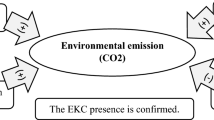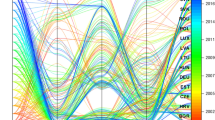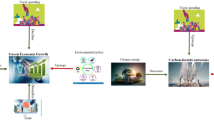Abstract
The green paradox describes an undesirable and socially inefficient phenomenon caused by the expansionary reactions of the supply as a response to the various mechanisms that combat climate change. This article seeks to understand and aggregate the different drivers of this phenomenon portrayed in the literature, as well the empirical evidence associated and the proposed solutions. For this purpose, compilation and systematization of the various scientific contributions up to date in this context have been elaborated and the driver’s effective impact on the European scenario was evaluated, using a balanced panel for 28 countries in Europe over 1996–2018 and the generalized method of moments (GMM) econometric procedure. Proxies for all provocateurs identified in the state of the art were incorporated in this study: (i) environmental taxes, (ii) green support, (iii) uncertain property rights, (iv) emissions limit (cap), and (v) temporal lag. The dependent variables used are (1) the ratio between the annual production/extraction of oil and the consumption of primary energy and (2) the carbon dioxide (CO2) intensity. We have obtained evidences that the hiatus in the implementation of the European emission cap mechanism has generated a strong green paradox. Moreover, a robust reflection regarding the economic and environmental adequacy of green supports should be considered due to its questionable net benefits. Lastly, we offer some recommendations of public environmental policies that escape the paradoxical phenomenon, through the enunciation of the conditionalities of these provocateurs.


Similar content being viewed by others
Availability of data and materials
The datasets generated and analysed during the current study are available in the following data sources and corresponding links, for each variable in the table below.
Variable | Source | |
|---|---|---|
Extraction of the non-renewable natural resource “oil” in relation to primary energy consumption | EUROSTAT | appsso.eurostat.ec.europa.eu/nui/show.do?dataset = nrg_cb_oil |
appsso.eurostat.ec.europa.eu/nui/show.do?dataset = nrg_bal_c | ||
Carbon intensity (CO2 emissions to GDP) | EUROSTAT | appsso.eurostat.ec.europa.eu/nui/show.do?dataset = env_air_gge |
appsso.eurostat.ec.europa.eu/nui/show.do?dataset = name_10_gdp | ||
Environmental tax revenue as a share of total tax revenue | EUROSTAT | appsso.eurostat.ec.europa.eu/nui/show.do?dataset = env_ac_tax |
appsso.eurostat.ec.europa.eu/nui/show.do?dataset = gov_10a_taxag | ||
Government expenditure on environmental protection as a share of total government expenditure | EUROSTAT | appsso.eurostat.ec.europa.eu/nui/show.do?dataset = gov_10a_exp |
appsso.eurostat.ec.europa.eu/nui/show.do?dataset = gov_10a_main | ||
Property rights | Heritage Foundation | |
Existence of an emissions limit system | Dummy variable | unfcc.int/process/the-kyoto-protocol/status-of-ratification |
Hiatus in the implementation of the emissions limit system | Dummy variable | unfcc.int/process/the-kyoto-protocol/status-of-ratification |
References
Andrade de Sá S, Daubanes J (2016) Limit pricing and the (in)effectiveness of the carbon tax. J Public Econ 139:28–39. https://doi.org/10.1016/j.jpubeco.2016.04.006
Arellano M, Bond S (1991) Some tests of specification for panel data: Monte Carlo evidence and an application to employment equations. Rev Econ Stud 58(2):277. https://doi.org/10.2307/2297968
Balsalobre-Lorente D, Leitão NC (2020) The role of tourism, trade, renewable energy use and carbon dioxide emissions on economic growth: evidence of tourism-led growth hypothesis in EU-28. Environ Sci Pollut Res 27(36):45883–45896. https://doi.org/10.1007/S11356-020-10375-1
Blundell R, Bond S (1998) Initial conditions and moment restrictions in dynamic panel data models. In J Econ 87:115–143
Blundell R, Bond S (2000) GMM estimation with persistent panel data: an application to production functions. Econ Rev 19(3):321–340. https://doi.org/10.1080/07474930008800475
Bohn H, Deacon RT (2000) Ownership risk, investment, and the use of natural resources. Am Econ Rev 90(3):526–549. https://doi.org/10.1257/aer.90.3.526
Bond SR, Hoeffler A, & Temple J (2001). GMM estimation of empirical growth models. No 3048, CEPR Discussion Papers, https://EconPapers.repec.org/RePEc:cpr:ceprdp:3048.
Cairns RD (2014) The green paradox of the economics of exhaustible resources. Energy Policy 65:78–85. https://doi.org/10.1016/j.enpol.2013.10.047
Cairns RD, Smith JL (2019) The green paradox, a hotelling cul de sac. Econ Energy Environ Policy 8(2):1–20. https://doi.org/10.5547/2160-5890.8.2.rcai
Carter, N. (2018). The Politics of the Environment: Ideas, Activism, Policy (3rd ed.). Cambridge: Cambridge University Press. doi:10.1017/9781108642163
Chen Y, Fan X, Zhou Q (2020) An inverted-u impact of environmental regulations on carbon emissions in china’s iron and steel industry: mechanisms of synergy and innovation effects. Sustainability (Switzerland) 12(3). https://doi.org/10.3390/su12031038
Di Maria C, Smulders S, Van der Werf E (2012) Absolute abundance and relative scarcity: environmental policy with implementation lags. Ecol Econ 74:104–119. https://doi.org/10.1016/j.ecolecon.2011.12.003
Di Maria C, Lange I, van der Werf E (2014) Should we be worried about the green paradox? Announcement effects of the acid rain program. Eur Econ Rev 69:143–162. https://doi.org/10.1016/j.euroecorev.2013.03.010
Doan TTT (2020) Determinants of financing decisions: evidence using GMM estimation. Accounting 6(5):681–686. https://doi.org/10.5267/j.ac.2020.6.016
Edenhofer O, Kalkuhl M (2011) When do increasing carbon taxes accelerate global warming? A note on the green paradox. Energy Policy 39(4):2208–2212. https://doi.org/10.1016/j.enpol.2011.01.020
Eichner T, Pethig R (2011) Carbon leakage, the green paradox, and perfect future markets*. Int Econ Rev 52(3):767–805. https://doi.org/10.1111/j.1468-2354.2011.00649.x
Fischer C, Salant SW (2012) Alternative climate policies and intertemporal emissions Leakage: Quantifying the Green Paradox. SSRN Electron J. https://doi.org/10.2139/ssrn.2047077
Fujisaki T (2018) Evaluation of green paradox: case study of Japan. Green Asia Education Center バージョン:published 権利関係: EVERGREEN Joint. J Novel Carbon Resource Sci Green Asia Strateg 05:26–31. https://doi.org/10.5109/2174855
Gerlagh R (2011) Too Much Oil. CESifo Econ Stud 57(1):79–102. https://doi.org/10.1093/CESIFO/IFQ004
Grafton, Kompas T, Van Long N (2012) Substitution between biofuels and fossil fuels: is there a green paradox? J Environ Econ Manag 64(3):328–341. https://doi.org/10.1016/j.jeem.2012.07.008
Grafton RQ, Kompas T, Van Long N, To H (2014) US biofuels subsidies and CO2 emissions: an empirical test for a weak and a strong green paradox. Energy Policy 68:550–555. https://doi.org/10.1016/j.enpol.2013.11.006
Granger CWJ (1981) Some properties of time series data and their use in econometric model specification. J Econ 16(1):121–130. https://doi.org/10.1016/0304-4076(81)90079-8
Granger CWJ, Newbold P (1974) Spurious regressions in econometrics. J Econ 2(2):111–120. https://doi.org/10.1016/0304-4076(74)90034-7
Hansen LP (1982) Large sample properties of generalized method of moments estimators. Econometrica 50(4):1029. https://doi.org/10.2307/1912775
Hoel M (2010) Is there a green paradox? CESifo Working Paper Series 3168. CESifo. https://ideas.repec.org/p/ces/ceswps/_3168.html Accessed 13 January 2020
Im KS, Pesaran MH, Shin Y (2003) Testing for unit roots in heterogeneous panels. J Econ 115(1):53–74. https://doi.org/10.1016/S0304-4076(03)00092-7
Kao C (1999) Spurious regression and residual-based tests for cointegration in panel data. J Econ 90(1):1–44. https://doi.org/10.1016/S0304-4076(98)00023-2
Keele L, Kelly NJ (2006) Dynamic models for dynamic theories: the ins and outs of lagged dependent variables. Polit Anal 14(2):186–205. https://doi.org/10.1093/pan/mpj006
Klepper G, Peterson S (2006) Marginal abatement cost curves in general equilibrium: the influence of world energy prices. Resour Energy Econ 28(1):1–23. https://doi.org/10.1016/j.reseneeco.2005.04.001
Kotlikoff LJ, Polbin AV, Zubarev AV (2021) Will the Paris accord accelerate climate change? Ekonomicheskaya Politika 2021(1):8–37. https://doi.org/10.18288/1994-5124-2021-1-8-37
Leitão NC, Lorente DB (2020) The linkage between economic growth, renewable energy, tourism, CO2 emissions, and international trade: the evidence for the European Union. Energies 13(18):4838. https://doi.org/10.3390/EN13184838
Levin A, Lin CF, Chu CSJ (2002) Unit root tests in panel data: Asymptotic and finite-sample properties. Journal of Econometrics, 108(1), 1–24. https://doi.org/10.1016/S0304-4076(01)00098-7
Lewis TR (1976) Monopoly exploitation of an exhaustible resource. J Environ Econ Manag 3(3):198–204. https://doi.org/10.1016/0095-0696(76)90019-X
Morley B (2012) Empirical evidence on the effectiveness of environmental taxes. Appl Econ Lett 19:1817–1820. https://doi.org/10.1080/13504851.2011.650324
Okullo SJ, Reynès F, Hofkes MW (2015) Modeling peak oil and the geological constraints on oil production. Resour Energy Econ 40:36–56. https://doi.org/10.1016/j.reseneeco.2015.01.002
Österle I (2012) The logic behind the green paradox. Rev Environ Energy Econ 2012:1–4. https://doi.org/10.7711/feemre3.2012.05.003
Pedroni P (1999) Critical values for Cointegration tests in heterogeneous panels with multiple Regressors. Oxf Bull Econ Stat 61(s1):653–670. https://doi.org/10.1111/1468-0084.0610s1653
Pedroni P (2000) Fully modified OLS for heterogeneous cointegrated panels. Adv Econ 15:93–130. https://doi.org/10.1016/S0731-9053(00)15004-2
Phillips PCB, Perron P (1988) Testing for a unit root in time series regression. Biometrika 75(2):335–346. https://doi.org/10.1093/biomet/75.2.335
Pigou A (1920). The economics of welfare (1st ed.) Macmillan and Co.
Ritter H, Schopf M (2014) Unilateral climate policy: harmful or even disastrous? Environ Resour Econ 58(1):155–178. https://doi.org/10.1007/s10640-013-9697-0
Sargan JD (1958) The estimation of economic relationships using instrumental variables. Econometrica 26(3):393. https://doi.org/10.2307/1907619
Sen P (2016) Unilateral emission cuts and carbon leakages in a dynamic north–south trade model. Environ Resour Econ 64(1):131–152. https://doi.org/10.1007/s10640-014-9860-2
Sinn HW (2008) Public policies against global warming: a supply side approach. Int Tax Public Financ 15(4):360–394. https://doi.org/10.1007/s10797-008-9082-z
Smulders S, Tsur Y, Zemel A (2012) Announcing climate policy: can a green paradox arise without scarcity? J Environ Econ Manag 64(3):364–376. https://doi.org/10.1016/j.jeem.2012.02.007
Stock JH, & Watson MW (2015). Introduction to econometrics (3rd ed.) Pearson Education Ltd.
Strand J (2007) Technology treaties and fossil-fuels extraction. Energy J 28(4):129–142 https://econpapers.repec.org/RePEc:aen:journl:2007v28-04-a06 Accessed 23 December 2020
Teeter P, Sandberg J (2017) Constraining or enabling green capability development? How policy uncertainty affects organizational responses to flexible environmental regulations. Br J Manag 28(4):649–665. https://doi.org/10.1111/1467-8551.12188
The Heritage Foundation. (2021). Index of Economic Freedom: Promoting Economic Opportunity and Prosperity by Country. https://www.heritage.org/index/ (accessed May 27, 2020)
The Kyoto Protocol: Status of Ratification. (2009). https://unfccc.int/process/the-kyoto-protocol/status-of-ratification Accessed 1 April 1 2020
van der Ploeg F (2020) Race to burn the last ton of carbon and the risk of stranded assets. Eur J Polit Econ 64:101915. https://doi.org/10.1016/j.ejpoleco.2020.101915
van der Ploeg F, Withagen C (2012) Is there really a green paradox? J Environ Econ Manag 64(3):342–363. https://doi.org/10.1016/j.jeem.2012.08.002
van der Ploeg F, Withageny C (2015) Global warming and the green paradox: a review of adverse effects of climate policies. Rev Environ Econ Policy 9(2):285–303. https://doi.org/10.1093/reep/rev008
Van Long N (1975) Resource extraction under the uncertainty about possible nationalization. J Econ Theory 10(1):42–53. https://doi.org/10.1016/0022-0531(75)90060-5
Yule GU (1926) Why do we sometimes get nonsense-correlations between time-series?--a study in sampling and the nature of time-series. J R Stat Soc 89(1):1. https://doi.org/10.2307/2341482
Zeraibi A, Balsalobre-Lorente D, Murshed M (2021) The influences of renewable electricity generation, technological innovation, financial development, and economic growth on ecological footprints in ASEAN-5 countries. Environ Sci Pollut Res 28:51003–51021. https://doi.org/10.1007/S11356-021-14301-X
Zhang K, Zhang ZY, Liang QM (2017) An empirical analysis of the green paradox in China: from the perspective of fiscal decentralization. Energy Policy 103:203–211. https://doi.org/10.1016/j.enpol.2017.01.023
Funding
This work was financially supported by the research unit on Governance, Competitiveness and Public Policy (UIDB/04058/2020) + (UIDP/04058/2020), funded by national funds through FCT - Fundação para a Ciência e a Tecnologia.
Author information
Authors and Affiliations
Contributions
All authors contributed to the study conception and design. Material preparation and data collection were performed by ART. Data analysis was performed by ART and by MR. The first draft of the manuscript was written by ART and MR commented on previous versions of the manuscript. All authors read and approved the final manuscript.
Corresponding author
Ethics declarations
Ethics approval and consent to participate
Not applicable.
Consent for publication
Not applicable.
Competing interests
The authors declare that they have no competing interests.
Additional information
Responsible Editor: Ilhan Ozturk
Publisher’s note
Springer Nature remains neutral with regard to jurisdictional claims in published maps and institutional affiliations.
Rights and permissions
About this article
Cite this article
Tavares, A.R., Robaina, M. Drivers of the Green Paradox in Europe: An empirical application. Environ Sci Pollut Res 30, 42791–42812 (2023). https://doi.org/10.1007/s11356-021-16856-1
Received:
Accepted:
Published:
Issue Date:
DOI: https://doi.org/10.1007/s11356-021-16856-1




